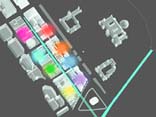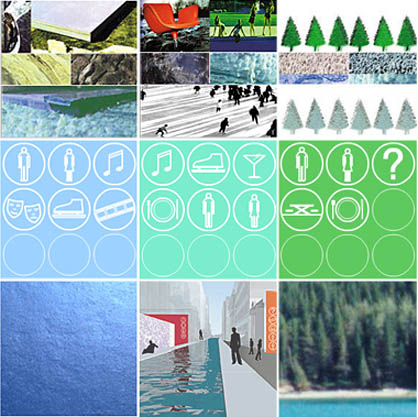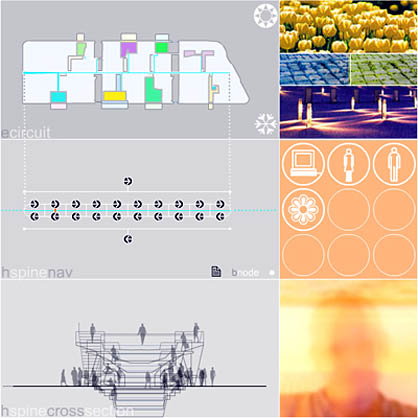|
|
||||
| BNODE. Place-Time-Symbol |
||||
| [in italiano] | The city of Ottawa is imbedded in a wide network of culture and history. The proximity of wilderness to the city has led to a particular kind of territorial transformation over the centuries. Today, a system of parkways, as well as roads and waterways participate in the generation of overlapping urban fields in Ottawa. In an effort to develop an environment for cultural, social, and leisure-oriented interfacing, and to promote the concept of the site as a cultural incubator and national culture platform, this project proposes to intensify activity in the three-block competition area through the following concepts and strategies: |
[25aug2001] | ||
 > ANIMATION |
TRANSFORMATION OF TERRITORY. The city is surrounded and penetrated by magnificent nature. A primary feature in the city is the Ottawa river. The Ottawa river is part of a waterway system that connects Ottawa to the Great Lakes, the Atlantic Ocean and also to Canada's southern neighbor - the United States. The wild character of the river is channelled into the city of Ottawa by the Rideau canal. NETWORK. Ottawa is imbedded in a network of waterways and pathways. This morphological condition can be tapped and extended in order to inject life into the core area of the city. WATER. The project proposes that water be used as a connective spine: the Ottawa river connects to the Rideau canal. We propose a strategy which involves branching off of the Rideau canal to create a small canal - the hydro-spine - which runs into the core area through a system of small locks, following Sparks street and bisecting the competition site. The hydro-spine constitutes a datum level for the experience of the inner city. As the topography in the core area is changing, a difference between water datum line and topography generates the beginning of new programmatic fields.  |
bnode is a New York City based architecture & design studio founded in 2000 by architects
Judith Gieseler and Innes Yates. bnode seeks to reconfigure the territories of architectural practice in order to broaden architecture's relevance within other creative practices, new media initiatives, and contemporary culture. Since 1994, the two have worked professionally in the fields of architecture, lighting design and new media design. Their research examines the changing roles and territories for architecture as it constantly adjusts to new cultural and technological parameters. Their experience is international in scope, including work in New York, Germany, Canada, France, and the Netherlands. Their independent work has been recognized internationally in architectural design competitions, including Place-Time-Symbol, Ottawa, Canada, 2000 (third prize), Bridging/Place de l’Architecture, Montréal, 1997 (first prize), and the Canadian Battle of Normandy memorial in Caen, France, 1994 (first prize). |
||
HYDRO SPINE. The hydro-spine is an element of continuity and connectivity injected into the existing urban fabric of the competition site. This fabric consists of a mixture of historic buildings, post-second world war structures and vacant areas - or voids. The hydro-spine continues the city's historical process of transforming territory into a kind of artificial nature - the interiorization of the natural within the artifice of the city. In this case, it is seen as an infrastructural measure which acts to establish connections and stimulate interaction between social, cultural, commercial, leisure-oriented and symbolic functions and activities. It is a conduit for urban living. The hydro-spine branches from the main "trunk" canal into smaller canals which lead towards the various spaces which constitute the episode circuit - spaces which are currently voids in the existing urban tissue. EPISODE CIRCUIT. The existing voids become the stage for spectacle. They form the episode circuit: public zones which are part of an urban mixture that moves between static program - basic programmatic provisions and parameters for a variety of cultural activities - and dynamic program - spectacle, performance, and experimentation. The episode circuit exists as a cultural interface for citizens: groups may apply to be granted "residency" in any one of the eight interior/exterior episode circuit zones for periods of four months to one year. Successful applicants will provide a program for the space according to their specific intentions, interests and expertise, creating an environment where their cultural vision and experiments can be shared with visitors. The episode circuit zones are pre-programmed with parameters which derive from their existing spatial and contextual qualities. These parameters, along with climactic factors, influence the way the spaces are occupied, and it is anticipated that groups will capitalize on these qualities to collectively produce stimulating results.  |
||||
| PROGRAM SURFACE AND PROGRAMMATIC FLUX. The cultural interface created by the episode circuit is intensified through its continually changing nature: it is in a constant state of growth and becoming, both in its programmatic, event-based change and through the changing nature of seasonal occupation of both interior and exterior environments. UNIFYING ELEMENT = WATER AND LIGHT. Changing events and spectacles are linked by water, light and surface. Programmatic flux takes place on a unifying layer of carefully chosen materials from different areas of Canada. The episode voids are filled with light during the night.  |
||||
| SEASONAL EXPANSION AND CONTRACTION. The eight zones of the episode circuit are influenced by seasonal change. For example, a zone could be occupied by pavilions of ice and light during the winter, and in the summer, projections of light, cinema, or performance. The waterspace across from the houses of parliament is a skating rink during the winter and part of an aquatic leisure environment during the summer. Each circuit zone has one building (appropriated from the existing fabric) assigned to it that is a "solid" generator: access to power, heat, water, information, restrooms and interior space is provided. RESIDENTIAL PHASE. The crystallization of residential communities would take place in a later phase of the development. The cyclical, fluid programming of the episode circuit would be accompanied by static programming: residential housing. A community would grow in this intensified field of program space - the exterior spaces of the episode circuits double as entry points to residential accommodation above the ground floor. bnode info@bnode.com |
||||
| Place-Time-Symbol, Ottawa, Canada 2000 |
||||

|
Place-Time-Symbol
was an international architecture & urban design competition held in Ottawa, Canada in the spring of 2000. The site of the competition is a three-block area opposite the canadian houses of parliament. bnode collaborated with Toronto architect and theorist Barry Bell on the project, which was awarded third prize by the jury. This is the competition text from the original entry. |
|||
|
>
BNODE
> ARCHITETTURE |
||||
per partecipare alla rubrica architetture laboratorio
|
||||